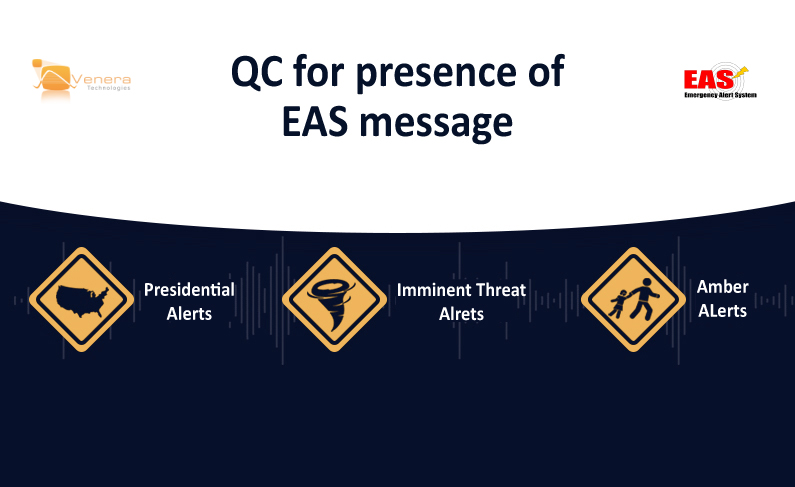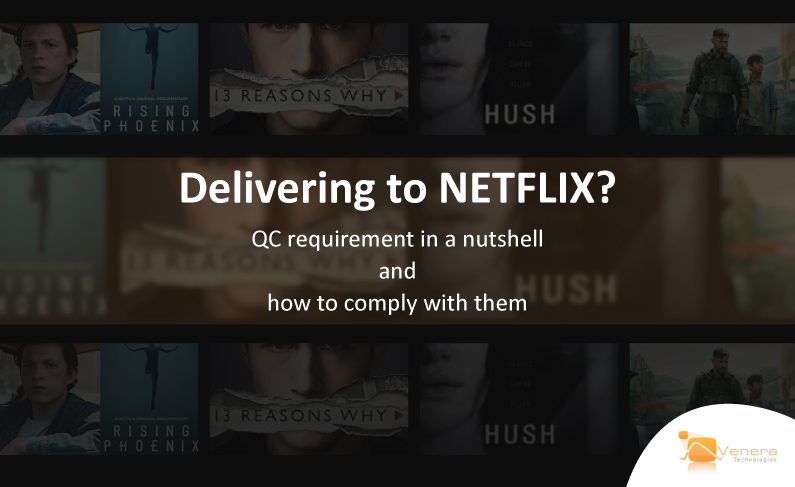
QC for Presence of Emergency Alert System (EAS) Message
The Emergency Alert System (EAS) is a national public warning system in the United States, commonly used by state and local authorities to deliver important emergency information, such as weather and AMBER alerts, to affected communities. EAS participants include radio and television broadcasters, cable systems, satellite radio, and television providers, and wireline video providers. These participants deliver local alerts on a voluntary basis, but they are required to provide the capability for the President to address the public during a national emergency. The majority of EAS alerts originate from the National Weather Service in response to severe weather events, but an increasing number of state, local, territorial, and tribal authorities also send alerts.
EAS messages are sent as part of the media delivery channel of various participants. Key characteristics of EAS messages include:
- Designed in a way that it immediately catches the attention of viewers to increase the probability of the general population listening to the emergency message and acting accordingly.
- It contains the location information so that the message is delivered only in the target geographies.
- Contains actual audio/video message warning the public.
Since the EAS messages are specifically designed for emergencies, it is prohibited to be used by participants for any other purposes, intentionally or unintentionally. Participants are not even allowed to transmit a tone that sounds similar to EAS messages. The simple rule is that no one is allowed to misuse EAS messages to attract attention to any other content such as advertisements, dramatic, entertaining, and educational programs, etc. To enforce this, FCC has imposed heavy penalties on various broadcasters for violating this rule. Some of the major pending or settled violations and their proposed or actual fines are listed here.
Many of these violations have been accidental but some of these have been because of creative intents also. One specific case is an episode of the TV show “Young Sheldon”. In the Season 1 episode titled “A Mother, A Child, and a Blue Man’s Backside,” Missy (Raegan Revord) is watching the classic “duck season/rabbit season” Looney Tunes short and is annoyed when a tornado-watch alert interrupts it. According to a source familiar with the situation, the scene used a muffled, background sound that was altered to balance the authenticity of a family’s reaction to a severe-weather event and the FCC’s rules against the misuse of the EAS tones. Nevertheless, FCC has proposed a $272,000 fine against CBS for this violation.
To avoid such penalties, broadcasters and other content providers must ensure that an audio tone similar to an EAS message is not present in the content they broadcast. Any missed instance can attract heavy penalties and would also potentially tarnish the brand image of that content provider. Therefore, every content must pass through stringent QC (validating there are no EAS tones) before getting delivered to the end-users.
EAS Message Structure
The EAS message structure is based on Specific Area Message Encoding (SAME). Messages in the EAS are composed of four parts: SAME header, an attention signal, an audio announcement, and SAME end-of-message marker; as described below:
- SAME Header: SAME header uses Audio Frequency Shift Keying (AFSK) at a rate of 520.83 bits per second to transmit the codes. It uses two frequencies – 2083.3 Hz (Mark frequency) and 1562.5 Hz (space frequency). Mark and space-time must be 1.92 milliseconds. Key information in the header includes originator, type of alert, region for which alert is issued, and date/time for which the alert is applicable.
- Attention signal. Single tone (1050 Hz) or Dual audio tone (853/960 Hz). Commercial broadcast operations use dual-tone (853 and 960 Hz together), while the single tone (1050 Hz) is used by NOAA weather radio. It is designed to attract the immediate attention of the listeners.
- Actual audio, video, or text message.
- SAME end-of-message marker. It indicates the end of the emergency alert.

File-based QC
File based QC tools are now commonly used in the content preparation and delivery chains, thereby reducing the dependency on manual QC. Many content providers resort to spot QC as against a full QC, exposing them to the risk of missing potential violations of FCC guidelines. Therefore, a QC tool that can reliably detect the presence of an EAS message or a tone similar to an EAS message can potentially save a content provider from the potential losses and embarrassment.
EAS message detection is part of all of our QC offerings – Pulsar & Quasar. As a result of QC, the report will contain the exact location of such violation that users can use to review and decide.

![]()
Our QC tools not only detect the ideal EAS message tones but can also report tones that sound similar to EAS message tones. Considering the case of “Young Sheldon” episode, this becomes important and can potentially save content providers from potential penalties.
We provide a range of QC tools for various deployments, be it on-premise or on Cloud. Whatever operational mode the users use, they can ensure that EAS tones are not present in the content they send out to end users.

Major EAS violations
Below is a list of some of the recent fines proposed by FCC for violation of EAS usage
- FCC has proposed a $20,000 fine on 7th April 2020, against New York City radio station WNEW-FM, for using the attention signal during its morning show on October 3, 2018, as part of a skit discussing the National Periodic Test held later that day
- FCC has proposed a fine of $272,000 against CBS for transmitting a simulated EAS tone during the telecast of Young Sheldon episode on 12th April 2018
- Meruelo Group was fined $61,000 for including an EAS-like tone during a radio advertisement for KDAY and KDEY-FM’s morning show
- ABC Networks is being fined $395,000 for using WEA (Wireless Emergency Alert) tones multiple times during a Jimmy Kimmel Live sketch
- iHeartMedia was fined $1 million on 19th May 2015, for the use of the EAS message during the 24th October 2014 episode of Bobby Bones nationally-syndicated radio show
- Cable providers fined $1.9 million on March 3, 2014, for misuse of EAS tones in the trailer for the 2013 film Olympus Has Fallen



